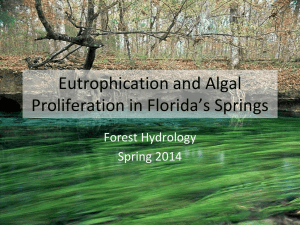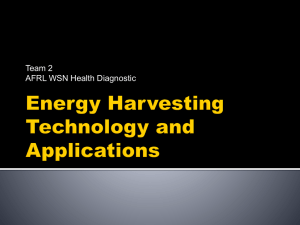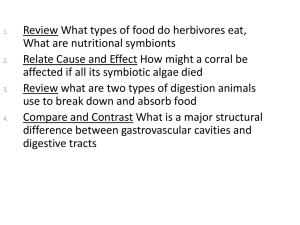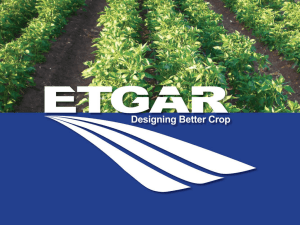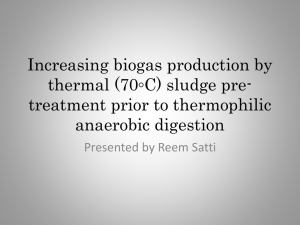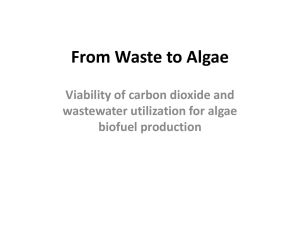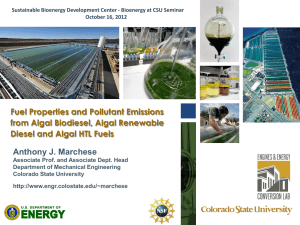Integrated process for biogas production from algal biomass
advertisement
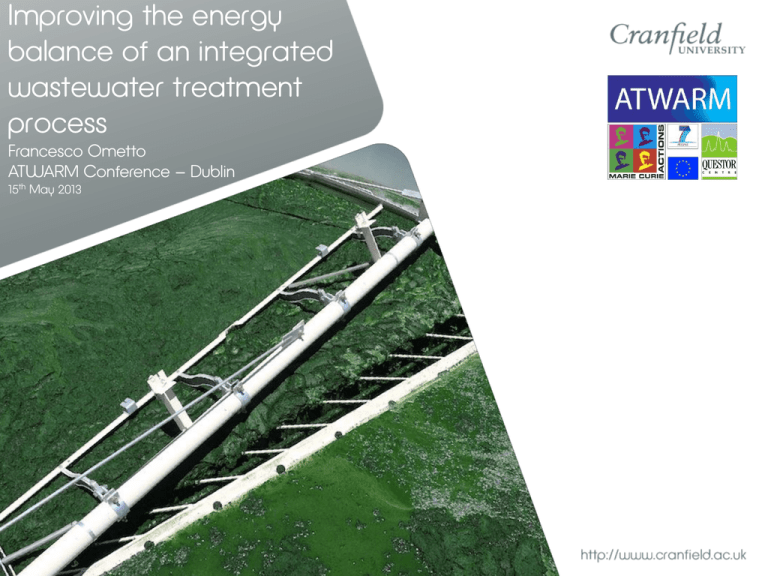
Improving the energy balance of an integrated wastewater treatment process Francesco Ometto ATWARM Conference – Dublin 15th May 2013 Project aim The aim of this work was to evaluate the energy demand and balance of an integrated microalgal wastewater treatment plant using different hypothetical scenarios. Wastewater Residual N and P AD Energy generation Algal treatment Clarified Water Activated Sludge (AS) Raceway Algae Pond Harvesting unit Pretreatment Anaerobic Digestion HARVESTING ISSUES Particle size/shape AOM (Algogenic Organic Matter) 3 S. obliquus C. vulgaris A. maxima 2.5 mg mg-1 2 1.5 1 0.5 0 EXP ST Scenedesmus obliquus EXP ST Chlorella vulgaris Carbohydrates:DOC EXP ST Chlorella vulgaris* EXP ST EXP ST ST Microcystis aeruginosa* Asterionella formosa* Arthrospira maxima Proteins:DOC Proteins:Carbohydrates Harvesting HARVESTING BDAF - Ballasted Dissolved Air Flotation (0.04 kWh m-3) Floc & bead aggregate Sludge scraper Hydrocyclone to separate floc and bead Separated beads leave from top & are recycled Micro beads New bead added to make up for any loss during recycle Clarified water Recycled bead are introduced at base of flocculation zone Bead pump Bead recycle line 60-80% less energy compare to DAF Flocculated material sinks to be removed from the base HARVESTING DAF vs BDAF performance S. obliquus cultivated in Jaworski Media 100% 80% 80% 60% 60% 40% 40% 20% 20% 0% 0% Removal 100% 0 10 pH 5 20 30 -1 Dose (mgAl l ) pH 7 40 pH 9 0 10 pH 5 20 30 -1 Dose (mgAl l ) pH 7 40% reduction on coagulant addition 40 pH 9 AD and pre-treatments Wastewater Residual N and P AD Energy generation Algal treatment Clarified Water Activated Sludge (AS) Raceway Algae Pond Harvesting unit Pretreatment Anaerobic Digestion DIGESTION ISSUES Algae cell wall - Strong resistance to bacteria degradation - Limited biogas production - Residual intact cell after digestion (40d) RESIDUAL CELL Pre-treatment to improve AD Thermal Hydrolysis (TH): • efficient sludge pre-treatment; • efficient combination of temperature and pressure to strongly effect the algal cell structure; Enzymes : • low energy treatment; • low knowledge; DIGESTION Experimental condition Thermal Hydrolysis (TH) system (autocleave and steam generator): - Algal sample 2% TS at 165°C/8 bar for 30min - sCOD, sProteins, sCarbohydrates Baskerville (Manchester, UK) Enzymes - Algal sample 2% TS at 50°C, pH 6 for 24h - sCOD, sProteins, sCarbohydrates BioMethane Test (BMT): - 40ml of sample at VSseed:VSsubstarte = 1:1 - 20ml nutrient solution* - 38°C at 135rpm - Methane/Biogas analyses avery 2-4 days * Angelidaki, I., Alves, M., Bolzonella, D., Borzacconi, L., Campos, J.L., Guwy, A.J., Kalyuzhnyi, S., Jenicek, P., van Lier J.B.: Defining the biomethane potential (BMP) of solid organic waste and energy crops: a proposed protocol for batch assays. Water Sci. Technol. 59, 927-934 (2009) DIGESTION Treatments effect (sCOD) 1000 S. obliquus C. sorokiniana A. maxima sCOD (mg/gVS) 600 400 800 600 400 200 200 0 0 105°, 1bar 120°, 2bar 145°, 3bar 155°, 5bar 165°, 7bar 105°+ S, 1bar 120°+ S, 2bar 145°+ S, 3bar 1000 sCOD (mg/gVS) sCOD (mg/gVS) 800 1000 800 600 400 200 0 Cellulase + Alpha amylase Endogalactour. Esterase + Protease Pectinase Esterase Mixture 155°+ S, 5bar 165°+ S, 7bar DIGESTION Biogas production (TH pre-treatment) 0.6 S. obliquus C. sorokiniana A. maxima 0.5 Biogas m3 kgVS-1 0.4 DIGESTED CELL 0.3 0.2 0.1 0 0 200 400 600 800 sCOD mg/g VS 1000 1200 1400 Energy balance Wastewater Residual N and P AD Energy generation Algal treatment Clarified Water Activated Sludge (AS) Raceway Algae Pond Harvesting unit Pretreatment Anaerobic Digestion Energy Balance TP230K Net Energy Balance (MWh Plant Efficiency d-1) 11.30 DAF 21.9821.98 (+17.68) BDAF 12.9412.94 (+1.64) 9.72 DAF 15.86 (+6.14) BDAF 6.82 (-2.90) Full data available: Ometto et all., 2013 “Improving the Energy Balance of an Integrated Microalgal Wastewater Treatment Process”, Waste and Biomass Valorization, DOI: 10.1007/s12649-013-9230-2 (%) Conclusions WWTP balance: - Inclusion of an algae reacotor can generate a more sustainable treatment plant with improved efficiency ranging from 55% (TP25K) to 75% (TP230K). Harvesting: - Importance of AOM, particle size and scape; - 60-80% energy reduction and 40% coagulant demand reduction using BDAF compare to traditional DAF; AD pre-treatment: - TH improved the biogas production by 90%. - TH improved the energy production by 50-60%. - Lower condition can be effective depending on the algal characteristics; - Enzymes are a species specific potential alternative; Future works How cultivate algae? - PBR - Open pond - Efficiency Ballasted flotation - Pilot plant Pre-treatments - Pilot plant - Algae/Primary Sludge Thanks for your attention ‟Nothing in life is to be feared, it is only to be understood.” Marie Curie (1867-1934) Project founded by EU Framework 7 project Advance Technologies for Water Resources and Management (ATWARM), Marie Curie ITN, No. 238273. Coordinated by QUESTOR Centre, Queen’s University – Belfast (UK)



